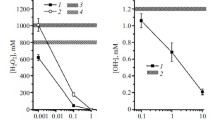Abstract
Hydroxyl radicals (·OH) and superoxide anion radicals (O2 ·−) are known to play cardinal roles in cell killing and various types of cell damage. In order to elucidate the mechanism of the involvement of both free radicals on apoptosis, the correlation between anti-apoptotic effects and free radical scavenging abilities of anti-oxidants was studied. As an indicator of anti-apoptotic effects, C1/2 (antioxidant concentration to inhibit DNA fragmentation by 50%) was evaluated in human lymphoma cell line U937 cells 6 hr after X-ray (10 Gy) or hyperthermia (44°C, 30 min) treatment. Rate constants of the reactions between antioxidants and ·OH or O2 ·− were calculated as the scavenging ability of the antioxidants with graded concentration estimated by EPR spectroscopy. No apparent correlation between C1/2 obtained in apoptosis induced by X-rays or hyperthermia and the rate constants of antioxidants for ·OH or O2 ·− was observed. On the other hand, the partition coefficients in 1-octanol/water of the antioxidants, an indicator of hydrophobicity, revealed a correlation with the C1/2 of the agents with hyperthermia, but not with X-ray irradiation. These results indicate that the prevention of apoptosis by an antioxidant is not simply associated with its scavenging ability for ·OH or O2 ·−. The hydrophobicity of the antioxidant, among other possible factors, is involved in the inhibition of hyperthermia- induced apoptosis.
Similar content being viewed by others
References
Salganik RI. The benefits and hazards of antioxidants: Controlling apoptosis and other protective mechanisms in cancer patients and the human population. J AmColl Nutr 2001; 20: 464S–472S.
Shackelford RE, Kaufmann WK, Paules RS. Oxidative stress and cell cycle checkpoint function. Free Radic Biol Med 2000; 28: 1387–1404.
Dizdaroglu M. Chemical determination of free radical-induced damage to DNA. Free Radic Biol Med 1991; 10: 225–242.
Riley PA. Free radicals in biology: Oxidative stress and the effects of ionizing radiation. Int J Radiat Biol 1994; 65: 27–33.
Kolesnick R, Fuks Z. Radiation and ceramide-induced apoptosis. Oncogene 2003; 22: 5897–5906.
Ojeda F, Diehl HA, Folch H. Radiation induced membrane changes and programmed cell death: Possible interrelationships. Scanning Microsc 1994; 3: 645–651.
Reddy MV, Gangadharam PR. Heat shock treatment of macrophages causes increased release of superoxide anion. Infect Immun 1992; 60: 2386–2390.
Galan A, Garcia-Bermejo L, Troyano A, et al. The role of intracellular oxidation in death induction (apoptosis and necrosis) in human promonocytic cells treated with stress inducers (cadmium, heat, X-rays). Eur J Cell Biol 2001; 80: 312–320.
Arai Y, Kondo T, Tanabe K, et al. Enhancement of hyperthermia-induced apoptosis by local anesthetics on human histiocytic lymphoma U937 cells. J Biol Chem 2002; 277: 18986–18993.
Li FJ, Kondo T, Zhao QL, et al. A lipophilic free radical initiator, 2,2'-azobis (2,4-dimethylvaleronitrile) (AMVN) enhances caspase-dependent apoptosis induced by hyperthermia. Int J Hyperthermia 2003; 19: 165–177.
Amicarelli F, Colafarina S, Cattani F, et al. Scavenging system efficiency is crucial for cell resistance to ROS-mediated methylglyoxal injury. Free Radic Biol Med 2003; 35: 856–871.
Shen DX, Shi X, Fu JL, Zhang YM, Zhou ZC. The role of thiol reduction in hydroquinone-induced apoptosis in HEK293 cells. Chem Biol Interact 2003; 145: 225–233.
Honda H, Kondo T, Zhao Q-L, Feril LB Jr, Kitagawa H. Role of intracellular calcium ions and reactive oxygen species in apoptosis induced by ultrasound. Ultrasound Med Biol 2004; 30: 683–692.
Hayashi Y, Kondo T, Zhao Q-L, et al. Signal transduction of p53-independent apoptotic pathway induced by hexavalent chromium in U937 cells. Toxicol Appl Pharmacol 2004; 197: 96–106.
Kojima Y, Kondo T, Zhao QL, Shoji M, Futatsuya R. Protective effects of cimetidine on radiation-induced micronuclei and apoptosis in human peripheral blood lymphocytes. Free Radic Res 2002; 36: 255–263.
McClain DE, Kalinich JF, Ramakrishnan N. Trolox inhibits apoptosis in irradiated MOLT-4 lymphocytes. FASEB J 1995; 9: 1345–1354.
Yuki H, Kondo T, Zhao QL, et al. A free radical initiator, 2,2'-azobis (2-aminopropane) dihydrochloride enhances hyperthermia-induced apoptosis in human uterine cervical cancer cell lines. Free Radic Res 2003; 37: 631–643.
Mates M. Effects of antioxidant enzymes in the molecular control of reactive oxygen species toxicology. Toxicology 2000; 153: 83–104.
Curtin JF, Donovan M, Cotter TG. Regulation and measurement of oxidative stress in apoptosis. J Immunol Methods 2002; 265: 49–72.
Sellins KS, Cohen JJ. Gene induction by gamma-irradiation leads to DNA fragmentation in lymphocytes. J Immunol 1987; 139: 3199–3206.
Hopcia KL, McCarey YL, Sylvester FC, Held KD. Radiation-induced apoptosis in HL60 cells: Oxygen effect, relationship between apoptosis and loss of clonogenicity, and dependence of time to apoptosis on radiation dose. Radiat Res 1996; 145: 315–323.
Kameda K, Kondo T, Tanabe K, et al. The role of intracellular Ca2+ in apoptosis induced by hyperthermia and its enhancement by verapamil in U937 cells. Int J Radiat Oncol Biol.Phys 2001; 49: 1369–1379.
Buxton GV, Greenstock CL, Phillip Helman W, Ross AB. Critical review of rate constants for reactions of hydrated electrons, hydrogen atoms and hydroxyl radicals (·OH/O2·−) in aqueous solution. J Phys Chem Ref Data 1988; 17: 513–886.
Finkelstein E, Rosen GM, Rauckman EJ. Spin trapping kinetics of the reaction of superoxide and hydroxyl radicals with nitrones. J AmChem Soc 1980; 102: 4994–4999.
Yoshikawa T, Kokura S, Tainaka K, et al. The role of active oxygen species and lipid peroxidation in the antitumor effect of hyperthermia. Cancer Res 1993; 53: 2326–2329.
Bretscher M, Cantley L, Cull-Candy S, et al. The plasma membrane. In: Alberts B, Bray D, Lewis J, Raff M, Roberts K, Watson J, eds. Molecular Biology of the Cell. New York: Garland Publishing Inc 1989: 276–341.
Author information
Authors and Affiliations
Rights and permissions
About this article
Cite this article
Cui, ZG., Kondo, T., Feril, L.B. et al. Effects of antioxidants on X-ray- or hyperthermia-induced apoptosis in human lymphoma U937 cells. Apoptosis 9, 757–763 (2004). https://doi.org/10.1023/B:APPT.0000045782.56480.6b
Issue Date:
DOI: https://doi.org/10.1023/B:APPT.0000045782.56480.6b




